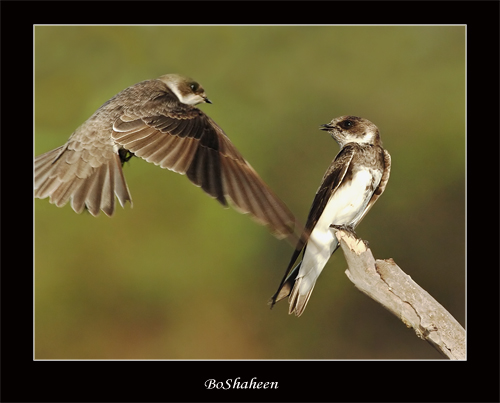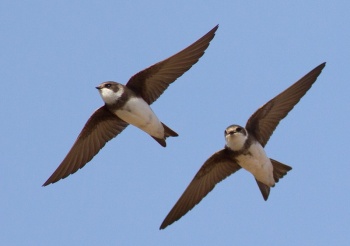Alternative names: Collared Sand Martin; Bank Swallow
- Riparia riparia
Identification
Length 12-13 cm (4¾-5 in)
- Dull earthy-brown upperparts
- White below
- Brown breast band
- Shallow forked tail
- Bill and legs are blackish-brown
Sexes similar
Juveniles: tertials and upper wing-coverts have pale fringes; breast band is less distinct.
Similar Species
The Eurasian Crag Martin is larger and flies more slowly.
Common Swifts appear all dark and very sickle or boomerang-shaped and are comparatively large compared to the three hirundines below.
Barn Swallows are mostly pale from below and all dark above, has much longer tail streamers, a black breast and red throat.
Western House Martin are very white below and dark from above, with much shorter, dark tail, and a prominent white rump
Sand Martin are pale from below with a dark throat band, but noticeably brown-coloured.
There is a difference in the flying style too: House martin flight is more fluttery than a Barn Swallow which is faster, more direct and swooping, while Sand Martin are more fluttery still, and Common Swift are very fast and look somewhat stiff-winged.
Finally, the calls are all quite distinct: swift calls are quite loud and screeching, while swallows are more twittery and varied. House martin and Sand Martin calls are quite similar, less sustained than swallows possibly, and more chirpy and clipped, with sand martin being slightly scratchier or hoarse sounding.
Distribution
Breeds in most of the northern hemisphere, wintering to Africa, southern Asia and South America.
Taxonomy
Pale Martin has been split from the present species.
Subspecies
Four subspecies are recognized:[1]
- R. r. riparia: Holarctic. Breeds in North America from Alaska to eastern Canada south broadly to northern United States, and patchily to southern United States and northeastern Mexico, and from Europe east through Russia, Turkey, Syria east to Siberia and central Asia; winters primarily in South America and Africa
- R. r. ijimae: Kamchatka Peninsula and Kuril Island to Amur River and Hokkaido
- R. r. shelleyi: Lower Egypt and Suez Canal region
- R. r. eilata: southern Israel
Habitat
Riverbanks, lakesides and sandpit, often seen in numbers hunting insects in low flight over lakes and rivers. Prior to and during migration they roost communally in large reedbeds
Behaviour
Diet
The diet includes insects, such as flies and spiders that are caught in flight.
Breeding
Breeds colonially in vertical sandy or earth banks, e.g. in gravel-pits and river banks, where nest is excavated (often a good metre horizontally into the earth).
The nest burrow is built by both parents; the chamber being lined with plant material and feathers. The eggs are white, and shiny. Incubation and care of the young is carried out by both parents.
Vocalisation
References
- Clements, J. F., T. S. Schulenberg, M. J. Iliff, S. M. Billerman, T. A. Fredericks, J. A. Gerbracht, D. Lepage, B. L. Sullivan, and C. L. Wood. 2021. The eBird/Clements checklist of Birds of the World: v2021. Downloaded from https://www.birds.cornell.edu/clementschecklist/download/
- Collins Pocket Guide to British Birds 1966
- Collins Field Guide 5th Edition
- Collins Bird Guide ISBN 0 00 219728 6
- British Garden Birds
- BF Member observations
Recommended Citation
- BirdForum Opus contributors. (2025) Sand Martin. In: BirdForum, the forum for wild birds and birding. Retrieved 11 May 2025 from https://www.birdforum.net/opus/Sand_Martin
External Links
Search the Gallery using the scientific name:
Search the Gallery using the common name:
GSearch checked for 2020 platform.







